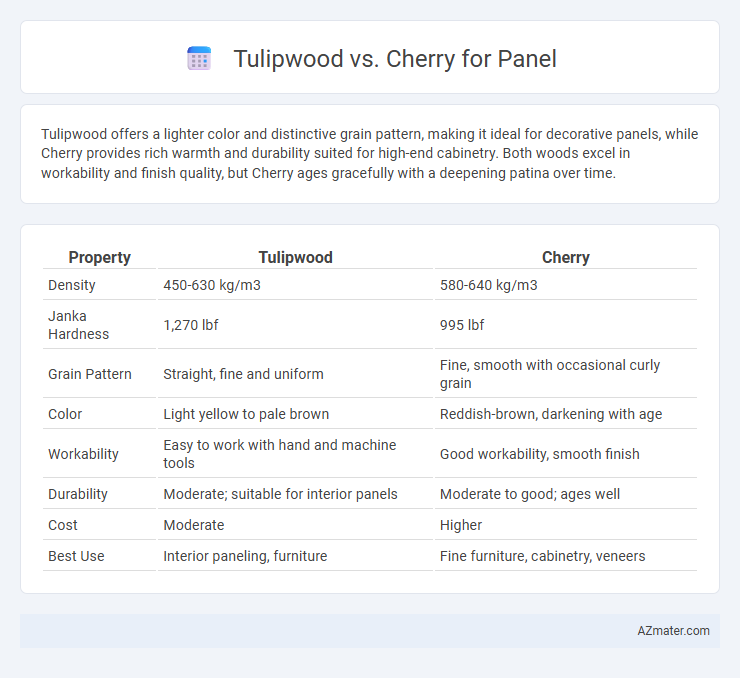Tulipwood offers a lighter color and distinctive grain pattern, making it ideal for decorative panels, while Cherry provides rich warmth and durability suited for high-end cabinetry. Both woods excel in workability and finish quality, but Cherry ages gracefully with a deepening patina over time.
Table of Comparison
| Property | Tulipwood | Cherry |
|---|---|---|
| Density | 450-630 kg/m3 | 580-640 kg/m3 |
| Janka Hardness | 1,270 lbf | 995 lbf |
| Grain Pattern | Straight, fine and uniform | Fine, smooth with occasional curly grain |
| Color | Light yellow to pale brown | Reddish-brown, darkening with age |
| Workability | Easy to work with hand and machine tools | Good workability, smooth finish |
| Durability | Moderate; suitable for interior panels | Moderate to good; ages well |
| Cost | Moderate | Higher |
| Best Use | Interior paneling, furniture | Fine furniture, cabinetry, veneers |
Introduction to Tulipwood and Cherry Panels
Tulipwood panels feature a light, creamy color with subtle grain patterns, making them ideal for modern and contemporary designs that require a clean and smooth surface. Cherry panels are prized for their rich, warm reddish-brown tones and fine, straight grain, offering a classic and elegant appearance that deepens with age. Both woods provide durable and versatile options for furniture and cabinetry, with tulipwood known for its stability and cherry wood for its unique aging characteristics.
Appearance and Color Characteristics
Tulipwood displays a distinctive appearance with a fine, straight grain and vibrant reddish-orange hues that darken to a rich reddish-brown over time, creating a striking visual impact for panels. Cherry wood features a smooth, closed grain with a warm, reddish tone that deepens to a rich mahogany shade, providing an elegant and classic aesthetic. Both woods offer unique color aging properties: Tulipwood's bold color shifts contrast with Cherry's subtle, consistent darkening, influencing panel selection based on desired visual effect.
Grain Patterns and Texture Differences
Tulipwood features a straight to slightly wavy grain with a fine, uniform texture that creates a smooth surface ideal for detailed paneling work. Cherry wood displays a more pronounced, fine to medium texture with distinctive, swirling grain patterns that deepen in color over time, adding character and warmth to panels. Both woods offer durability, but tulipwood's consistent grain provides a cleaner, modern look while cherry's varied grain and rich patina lend a classic, elegant appeal to cabinetry and furniture panels.
Durability and Hardness Comparison
Tulipwood and cherry are both popular hardwoods used for panels, with tulipwood exhibiting a Janka hardness rating of approximately 1,290 lbf, making it moderately hard and resistant to dents. Cherry wood, with a Janka hardness rating around 995 lbf, is softer but offers excellent durability and ages gracefully with a rich patina. Overall, tulipwood provides greater hardness and resistance to wear, while cherry is favored for its stability and warm aesthetic in panel applications.
Workability and Machining Qualities
Tulipwood offers excellent workability with a fine, even texture that allows for smooth machining and easy shaping, making it ideal for intricate panel designs. Cherry wood, known for its moderate hardness and uniform grain, machines cleanly with minimal wear on tools, providing a consistent finish and strong surface durability. Both woods respond well to sanding and finishing, but tulipwood's softness makes it more forgiving in detailed cuts, while cherry's stability ensures long-lasting, high-quality panels.
Cost and Availability Considerations
Tulipwood tends to be more affordable than cherry wood, making it a cost-effective option for paneling projects with budget constraints. Availability of tulipwood is generally higher due to its faster growing cycles and widespread North American distribution, while cherry wood, prized for its rich color and fine grain, is less abundant and often more expensive. Choosing between tulipwood and cherry for panels requires balancing the lower cost and greater availability of tulipwood against the premium aesthetic and durability of cherry wood.
Finishing and Staining Results
Tulipwood offers a light, creamy color with subtle grain patterns that absorb stains unevenly, often resulting in a blotchy appearance unless preconditioners are used. Cherry wood features a rich, reddish-brown hue that darkens smoothly over time and stains evenly, making it ideal for uniform finishes. Finishing tulipwood requires careful sanding and sealing to avoid blotching, while cherry responds well to a wide range of stains and finishes, enhancing its natural warmth and depth.
Environmental Impact and Sustainability
Tulipwood and cherry differ significantly in environmental impact and sustainability, with tulipwood generally sourced from fast-growing, abundant trees, making it a more renewable option for panels. Cherry wood, prized for its durability and rich color, comes from slower-growing trees, which can contribute to deforestation if not harvested responsibly. Choosing tulipwood for paneling supports sustainable forestry practices and reduces carbon footprint due to its quicker growth cycle and efficient reproduction rate.
Best Applications for Tulipwood vs. Cherry
Tulipwood is best suited for decorative paneling and furniture where a vibrant, golden-yellow hue with contrasting darker streaks enhances the aesthetic appeal, making it ideal for unique accent panels and cabinetry. Cherry wood excels in applications requiring durability and a rich, warm reddish-brown finish, such as high-end cabinetry, fine furniture, and architectural millwork where aging to a deep patina adds value. Both woods perform well in indoor environments but choosing Tulipwood or Cherry depends on desired color tones, workability, and resistance to wear in panel projects.
Final Thoughts: Choosing the Right Wood for Panels
Tulipwood offers a lighter color and consistent grain, making it ideal for modern panel designs that benefit from a smooth, uniform appearance, while cherry wood provides a rich, warm tone that deepens over time, adding classic elegance and character to any panel. Durability-wise, cherry is moderately hard and resists dents better than tulipwood, which tends to be softer but easier to machine and finish. Selecting the right wood depends on the desired aesthetic, wear resistance, and maintenance preferences for your panel project.

Infographic: Tulipwood vs Cherry for Panel
 azmater.com
azmater.com